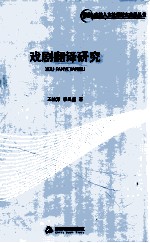图书介绍
戏剧翻译研究pdf电子书版本下载

- 王桂芳,李昌盛著 著
- 出版社: 北京:中国书籍出版社
- ISBN:9787506834834
- 出版时间:2014
- 标注页数:108页
- 文件大小:18MB
- 文件页数:121页
- 主题词:戏剧文学-英语-文学翻译-研究
PDF下载
下载说明
戏剧翻译研究PDF格式电子书版下载
下载的文件为RAR压缩包。需要使用解压软件进行解压得到PDF格式图书。建议使用BT下载工具Free Download Manager进行下载,简称FDM(免费,没有广告,支持多平台)。本站资源全部打包为BT种子。所以需要使用专业的BT下载软件进行下载。如 BitComet qBittorrent uTorrent等BT下载工具。迅雷目前由于本站不是热门资源。不推荐使用!后期资源热门了。安装了迅雷也可以迅雷进行下载!
(文件页数 要大于 标注页数,上中下等多册电子书除外)
注意:本站所有压缩包均有解压码: 点击下载压缩包解压工具
图书目录
Chapter 1 Drama and Dramatic Language 1
1.1 Drama,Play and Theater 1
1.2 The Dualistic Nature of Drama 3
1.3 Features of Dramatic Language 4
1.3.1 Implicitness and Rhetoric 5
1.3.2 Colloquialism 6
1.3.3 Brevity 8
1.3.4 Individuality 9
1.3.5 Gestic Codes of the Language 11
1.3.6 Summary 14
Chapter 2 Literature Review 15
2.1 A Survey of Drama Translation Studies 15
2.1.1 Studies of Drama Translation in China 15
2.1.2 Studies of Drama Translation outside China 16
2.2 Particularities of Drama Translation 20
2.3 Principles and Criteria of Drama Translation 21
2.3.1 Dynamic Equivalence and Functional Equivalence 22
2.3.2 Equivalent Effect Translation 23
2.3.3 Performability Principle 24
2.4 Perspectives,Strategies and Methods of Drama Translation 26
2.5 Summary of the Chapter 28
Chapter 3 Translating Performability-A Pragmatic Approach 30
3.1 Necessity to Apply Pragmatic Approach to Drama Translation 30
3.2 Introduction to Pragmatics 32
3.2.1 Speech Act Theory 33
3.2.2 Cooperative Principle 35
3.2.3 Politeness Theory 38
3.2.4 Context Theory 43
3.3 Application of Pragmatics in Drama Translation 45
3.3.1 Application of Speech Act Theory in Drama Translation 46
3.3.2 Application of Cooperative Principle in Drama Translation 55
3.3.3 Application of Politeness Theory in Drama Translation 62
3.3.4 Application of Context Theory in Drama Translation 68
3.4 Summary of the Chapter 80
Chapter 4 Translating Performability—A Comparative Case Study of the Two English Versions of Teahouse 81
4.1 Colloquialism and Brevity 81
4.2 Individuality 84
4.3 Gestic Codes 87
4.4 Intelligibility 91
4.4.1 Culture-loaded Words 91
4.4.2 Addressing Terms and Names with“爷” 94
4.4.3 Beijing Dialect 96
Chapter 5 Concluding Remarks 99
Bibliography 102
Index 108